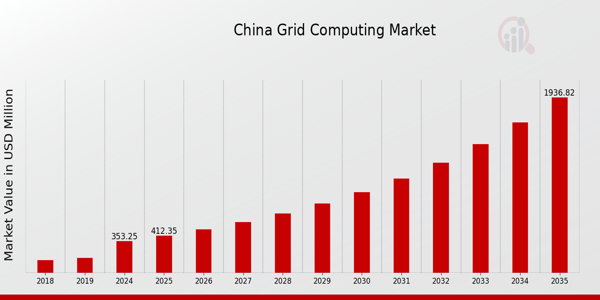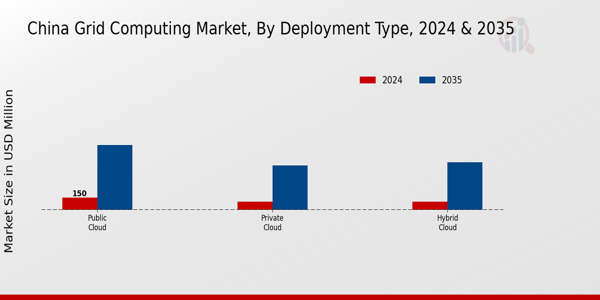China Grid Computing Market Overview
As per MRFR analysis, the China Grid Computing Market Size was estimated at 309.87 (USD Million) in 2023.The China Grid Computing Market is expected to grow from 353.25(USD Million) in 2024 to 1,936.85 (USD Million) by 2035. The China Grid Computing Market CAGR (growth rate) is expected to be around 16.73% during the forecast period (2025 - 2035).
Key China Grid Computing Market Trends Highlighted
The growing need for effective data processing solutions and the emergence of big data applications in several industries are driving the China Grid Computing Market's notable expansion. Grid computing technology investments have been sparked by the government's drive for digital transformation, especially through programs like the "Made in China 2025" policy.
By integrating cutting-edge computing resources, this action seeks to promote innovation and increase industrial efficiency. Grid computing systems are also becoming more and more popular as a result of the growing integration of cloud computing and IoT devices, which makes them crucial for resource management and real-time data analytics.
The Chinese grid computing market is full with opportunities, especially as digital companies want to collaborate with sectors like healthcare, banking, and transportation. These industries want to use grid computing's capacity to evaluate enormous amounts of data in order to make better decisions and run their businesses more effectively.Furthermore, the need for smart city solutions is growing as a result of urbanization, which creates an ideal environment for grid computing applications. Coherent and scalable computational resources are essential for efficiently administering public services and infrastructure.
Within China's grid computing framework, there has been a discernible shift in recent years toward energy-efficient and sustainable computing technologies. Businesses are giving priority to methods that lower their carbon footprint while maintaining high computing performance as environmental concerns gain traction.
This change is in line with national objectives to lower energy use and improve sustainability in a range of sectors. Furthermore, advancements in the grid computing environment are being driven by the increased interest in AI and machine learning technologies, indicating an era of transformation for computational activities in China.All things considered, the country's grid computing industry is becoming more dynamic and changing as a result of these developments coming together.

Source: Primary Research, Secondary Research, Market Research Future Database and Analyst Review
China Grid Computing Market Drivers
Growing Demand for High-Performance Computing
The China Grid Computing Market is experiencing a significant surge in demand for high-performance computing capabilities. With the growing complexity of data and the need for faster processing speeds, organizations are increasingly turning to grid computing.
The Ministry of Industry and Information Technology of China reported a 15% annual growth in high-performance computing usage across various sectors such as finance, healthcare, and scientific research between 2020 and 2023.
Established organizations like Alibaba Cloud and Tencent have advanced their infrastructure to support high-performance computing solutions, thereby enhancing their service offerings. This move not only bolsters their market positioning but also stimulates the overall demand for grid computing solutions, contributing to a positive growth trajectory in the China Grid Computing Market.
Government Support and Initiatives
The promotion of grid computing technologies has gained momentum through various government initiatives in China aimed at bolstering information technology. The Chinese government has allocated substantial fundingover USD 100 billionto enhance the information infrastructure, which includes grid computing technologies as part of its 14th Five-Year Plan.
This plan emphasizes the importance of building digital intelligence and enhancing computing capabilities. Organizations such as China National Grid Corporation are actively facilitating the implementation of grid computing technologies nationwide, leading to increased investment in the China Grid Computing Market. This strategic push from the government is a key driver for market growth.
Rise in Big Data Analytics
As the data ecosystem expands, the demand for big data analytics is driving growth in the China Grid Computing Market. According to the China Internet Network Information Center, the volume of data generated in China reached 8.7 zettabytes in 2023 and is projected to grow to 20.6 zettabytes by 2030.
This exponential increase in data has led corporations and academic institutions to seek advanced analytical capabilities provided by grid computing frameworks.
Companies like Baidu and Huawei are investing heavily in grid computing solutions to handle big data analytics efficiently, thereby positioning themselves as leaders in the market. As organizations realize the value of data-driven decision-making, the push towards grid computing platforms is expected to fuel market expansion.
China Grid Computing Market Segment Insights
Grid Computing Market Deployment Type Insights
The China Grid Computing Market shows significant development across various Deployment Type categories, namely Private Cloud, Public Cloud, and Hybrid Cloud. The emphasis on these deployment types is primarily driven by the increasing demand for cost-effective and scalable computing solutions in China.The Private Cloud segment resonates with organizations that prioritize data security and customization. It offers dedicated resources that are tailored to specific business requirements, which is increasingly important given the growing data privacy concerns in the region.
Meanwhile, the Public Cloud segment remains popular due to its flexibility and lower initial costs, making it accessible for startups and small businesses. This model supports the rapid scalability necessary for businesses aiming to respond swiftly to changing market conditions and consumer demands.
The Hybrid Cloud approach is becoming the preferred choice for many enterprises, as it combines the advantages of both Private and Public Clouds, allowing companies to scale their operations while maintaining control over sensitive data.This segment is particularly significant in light of the ongoing digital transformation initiatives undertaken by numerous industries in China, which seek to leverage both public and private resources efficiently. According to recent statistics, investment in cloud infrastructure is expected to soar, driving further adoption across all deployment types.
The ability to integrate multiple deployment models allows organizations in China to be more agile and innovative, thus fostering a competitive edge in an increasingly digitized economy. The grid computing landscape in China thus reflects a broad spectrum of adoption, illustrating the diverse needs across different sectors and the growth potential in this market.As enterprises navigate the complex terrain of IT infrastructures, the deployment types of cloud computing not only provide the necessary tools for operational efficiency but also open doors to new opportunities and growth avenues that align with China's economic objectives.

Source: Primary Research, Secondary Research, Market Research Future Database and Analyst Review
Grid Computing Market Organization Size Insights
The Organization Size segmentation within the China Grid Computing Market plays a pivotal role in shaping the industry's landscape. This market encompasses diverse entities ranging from Small and Medium Enterprises to Large Enterprises, each contributing uniquely to the overall dynamics.Small and Medium Enterprises represent a vibrant sector that is increasingly adopting grid computing solutions to enhance operational efficiency and drive innovation, often leveraging these technologies for cost-effectiveness and scalability.
On the other hand, Large Enterprises are significantly investing in grid computing to streamline processes, manage extensive data sets, and support complex applications, thus enjoying a major influence in setting market trends and driving demand.The growth of this segment is fueled by the increasing adoption of digital transformation initiatives, a rising need for data management, and cloud computing developments in China.
Furthermore, as the government emphasizes technological advancements and infrastructure development, opportunities for both Small and Medium Enterprises and Large Enterprises are expanding, creating a conducive environment for robust market growth.This segmentation analysis provides critical insights into the varying needs and capabilities of organizations in China, which is essential for tailoring targeted solutions and services in the grid computing landscape.
China Grid Computing Market Key Players and Competitive Insights
The China Grid Computing Market has seen significant evolution and expansion in recent years, influenced by advancements in computing technologies and the increasing demand for data processing capabilities across various sectors.As an emerging field within the broader technology landscape, grid computing facilitates the sharing and processing of resources across distributed networks, catering to diverse industries including finance, healthcare, and research.
The competitive landscape in this market is characterized by numerous players striving to exploit the growing opportunities driven by digital transformation and the adoption of cloud technologies. Key companies are focusing on innovation, infrastructure investment, and strategic partnerships to enhance their market positions, create value propositions, and meet the evolving needs of clients.
Key Companies in the China Grid Computing Market Include:
- Huawei
- Baidu
- China Telecom
- Lenovo
- Tencent Cloud
- Inspur
- Alibaba Cloud
China Grid Computing Market Developments
Huawei started supplying Chinese data centers with its CloudMatrix 384 clusters in early 2025. These clusters, which connect 384 Ascend 910C processors via optical supernode interconnects, are positioned as a domestic high-performance AI infrastructure competitor to Nvidia's systems, offering a 67% higher compute output than GB200-based NVL72 units, albeit at a higher energy and operating cost.
Simultaneously, in mid-2023, Baidu placed a substantial order for about 1,600 Huawei Ascend 910B chips, worth about CNY 450 million, to support the training of its Ernie large language model. This indicates a tangible grid-scale implementation of Huawei's chip architecture within Baidu's artificial intelligence infrastructure.
A milestone in grid computing self-sufficiency for critical industries was reached in late 2024 when China Telecom reported that it has trained two massive LLMs, including one with over a trillion parameters, using chips made wholly in the country.
Aiming to convert current distributed cloud nodes into intelligent cloud nodes, Inspur Cloud concurrently started a "distributed intelligent cloud" upgrading program in line with China's AI Plus policy. By the end of 2025, the company hopes to have over 1,000 upgraded nodes.
Additionally, Tencent Cloud introduced renewable-powered microgrids at data centers that run on solar and wind power to support grid-scale computing in an environmentally sustainable way. Tencent Cloud also unveiled its Xingmai high-performance computing network, which can support up to 100,000 GPUs, improving communication performance tenfold and lowering model-training costs by up to 60%.
China Grid Computing Market Segmentation Insights
Grid Computing Market Deployment Type Outlook
-
- Private Cloud
- Public Cloud
- Hybrid Cloud
Grid Computing Market Organization Size Outlook
-
- Small & Medium Enterprise
- Large Enterprise
| Report Attribute/Metric Source: |
Details |
| MARKET SIZE 2023 |
309.87(USD Million) |
| MARKET SIZE 2024 |
353.25(USD Million) |
| MARKET SIZE 2035 |
1936.85(USD Million) |
| COMPOUND ANNUAL GROWTH RATE (CAGR) |
16.73% (2025 - 2035) |
| REPORT COVERAGE |
Revenue Forecast, Competitive Landscape, Growth Factors, and Trends |
| BASE YEAR |
2024 |
| MARKET FORECAST PERIOD |
2025 - 2035 |
| HISTORICAL DATA |
2019 - 2024 |
| MARKET FORECAST UNITS |
USD Million |
| KEY COMPANIES PROFILED |
Kingsoft Cloud, Digital China, Huawei, Adeptia, China Mobile, Baidu, China Telecom, Lenovo, Tencent Cloud, Inspur, Alibaba Cloud, ZTE Corporation, China Unicom, NEC Corporation, JD Cloud |
| SEGMENTS COVERED |
Deployment Type, Organization Size |
| KEY MARKET OPPORTUNITIES |
Growing demand for data processing, Expansion of AI and ML applications, Increased cloud computing adoption, Government investments in infrastructure, Rising need for real-time analytics |
| KEY MARKET DYNAMICS |
scalable infrastructure demand, increasing data processing needs, government support initiatives, rising cloud adoption, growing cybersecurity concerns |
| COUNTRIES COVERED |
China |
Frequently Asked Questions (FAQ):
The China Grid Computing Market is expected to be valued at 353.25 million USD in 2024.
By 2035, the China Grid Computing Market is projected to reach a value of 1936.85 million USD.
The expected CAGR for the China Grid Computing Market from 2025 to 2035 is 16.73%.
In 2024, the Private Cloud segment of the China Grid Computing Market is valued at 100 million USD.
The Public Cloud segment is anticipated to be valued at 800 million USD by 2035.
The Hybrid Cloud segment is expected to be valued at 103.25 million USD in 2024 and 586.85 million USD in 2035.
Major players in the China Grid Computing Market include Kingsoft Cloud, Alibaba Cloud, Huawei, and Tencent Cloud.
The market presents growth opportunities in enhancing cloud technologies and expanding into underserved sectors.
Yes, the market is witnessing a significant growth trend, driven by increased demand for cloud and grid computing solutions.
The competitive landscape in 2025 will be driven by leading companies like Digital China and JD Cloud, competing for market shares in various segments.
















